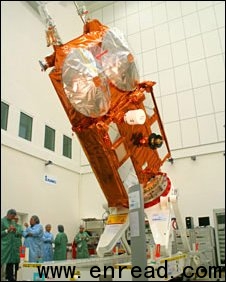| ||||||||||||||||||||||||||||||||||||||||||||||||
|
the european space agency's mission to assess the state of the world's ice cover is likely to launch in february. 欧洲航天局评定世界冰覆盖量的任务将要于明年二月实施。  scientists hope data from cryosat will show where arctic ice is melting fastest the cryosat spacecraft will go into orbit on a dnepr rocket from baikonur, kazakhstan, the agency has announced. the satellite is a rebuild of the mission that was destroyed in 2005 when its launcher failed just minutes into its flight. cryosat-2's 1 instrument will make 2 maps of the ice that covers both sea and land at the poles. data from other satellites, such as the us icesat and the european ers/envisat missions, has already indicated that some of this cover is diminishing(逐渐缩小的) at a rapid rate in response to climate change, with the biggest melting occurring in the arctic. cryosat will add significantly to the information scientists already possess, making observations that are beyond the current generation of spacecraft. get ahead the completed cryosat-2 is undergoing final checks here at the iabg technical centre in ottobrunn near munich, germany, a test facility used by satellite manufacturers. the mission is led scientifically from the uk, however. its principal 3 is professor duncan wingham at university college london. it was hoped cryosat-2 could launch in december, but the flight has been delayed now until next year. esa said there was a queue of missions waiting for a ride on the russian-ukrainian dnepr rocket, an intercontinental ballistic missile(洲际导弹) that has been converted for use by civil space programmes. "yes, it's 4, but that's how it is," conceded volker liebig, esa's director of earth observation programmes. "on the other hand it gives us a little bit more time to prepare the ground segment and the processing chain, which means when we do get into orbit we'll be ready to start operations rapidly because of all the work we've done in advance." mission managers are targeting 28 february for a launch. the inability of the agency to 5 its satellites at a time of its choosing should become less of a problem when it has access to its new vega rocket. vega, which will operate out of europe's kourou spaceport in french guiana, has been designed specifically to carry small institutional payloads such as cryosat to orbit. however, the rocket is not expected to enter into service until the middle of next year. cryosat-2 is part of esa's earth explorer programme - seven spacecraft that will do 6(革新的,创新的) science in obtaining data on issues of pressing environmental concern. the first in the series, goce (gravity field and steady-state ocean circulation), was launched in march. 点击  收听单词发音 收听单词发音
|
||||||||||||||||||||||||||||||||||||||||||||||||
- 发表评论
-
- 最新评论

